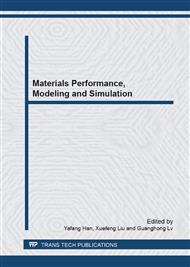[1]
T.A. Mai, A.C. Spowage, Characterisation of dissimilar joints in laser welding of steel-kovar, Copper-steel and Copper-Aluminum, Mat. Sci. Eng. A-Struct, 374 (2004) 224-233.
DOI: 10.1016/j.msea.2004.02.025
Google Scholar
[2]
B. Kurt, M. Ulutan, Interfacial microstructure of diffusion bonded Inconel 738 and ferritic stainless steel couple, J. Mater. Sci. Tech., 25 (2009) 527-530.
Google Scholar
[3]
X.J. Sun, J. Tao, X.Z. Guo, Interface microstructure and bonding strength of Fe/Al double metal composite pipe by explosive method, Materials for mechanical engineering, 35 (2011) 35-42.
Google Scholar
[4]
J.T. Zou, P. Xiao, J.J. Jin, et al., Investigation on the interface transition layer of CuNiMn/ 30CrMnSi integral material, Foundry technology, 28 (2010) 1379-1382.
Google Scholar
[5]
J.T. Zou, Y.F. Liu, X.H. Wang, et al., Effect of melt-casting temperature on bonding zone of CuNiMnFe/30CrMnSi integral material, Advanced materials research, 148-149 (2011) 664-667.
DOI: 10.4028/www.scientific.net/amr.148-149.664
Google Scholar
[6]
C.W. Xu, Y. Li, S.Z. Wei, et al., Study on the microstructure and property of roller interface of high Vanadium high speed steel 35CrMo, Foundry technology, 28 (2007) 319-322.
Google Scholar
[7]
X.L. Cheng, Y.M. Gao, J.D. Xing, et al., Investigation into intermetallic compounds in Al/ Ni/0Cr18Ni9Ti diffusion bonded joint, Journal of Xi'an Jiao Tong University, 41 (2007) 867-869.
Google Scholar
[8]
B.M. Li, X.G. Li, G.M. Xu, Study and application of Cu/steel clad metal, Materials Review, 16 (2002) 22-26.
Google Scholar
[9]
W. Guo, X.H. Zhao, M.X. Song, Status and development of theory about interface of diffusion welding, Aerospace Manufacturing Technology, 10 (2004) 36-39.
Google Scholar
[10]
K.S. He, X.F. Cao, Welding of heterogeneity metal, Mechanic industry press, Beijing, 1986, pp.113-124.
Google Scholar
[11]
H.Y. Fang, J.C. Feng, Interface behavior of materials bonding, Harbin institute of technology press, Harbin, (2005).
Google Scholar
[12]
L. Gao, Z.X. Li, G.D. Li, Research status and development of Copper-steel welding, Welding, 12 (2006) 16-19.
Google Scholar
[13]
C.X. Pan, Dissimilar steel and dissimilar metal welding, China communications press, Beijing, (2000).
Google Scholar
[14]
Y.J. Li, J. Wang, P. Liu, Low-alloy steel welding and engineering applications, Chemical industry press, Beijing, 2003, pp.7-9.
Google Scholar


